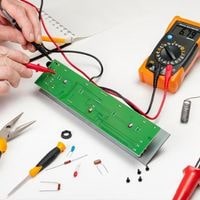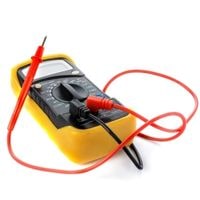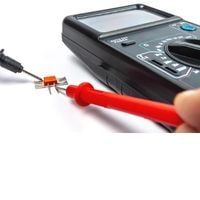How to test a run capacitor with a multimeter. If your central air conditioning system or furnace isn’t working properly, it might be a defective run capacitor that’s to blame.
A run capacitor is a powerful and essentially invisible part of heavy machinery and because it retains an electrical charge even after being unplugged or the power is turned off installing one into your home’s electrical system can leave you at risk of bad things happening if left unchecked.
How does a run capacitor work?
A capacitor is a device used for storing electricity. This can be provided by external power sources such as solar energy. A single run capacitor may contain anode and cathode.
However, a dual-run capacitor has two separate charge terminals. Single run capacitors are used to power motors and they can be found in air conditioners, refrigerators, and other appliances.
A dual-run capacitor supports a fan motor that is powered through direct current (DC) only and it is connected to the electrical circuit of the compressor of heating devices like air conditioners or water heaters.
How to test a run capacitor with a multimeter
You should use an Ohmmeter to test a capacitor’s ability to store and release an electrical charge. You can also test the component to determine if it has the proper capacitance rating by measuring the microfarads present in the capacitor.
This second test can be done using a capacitor tester or a multimeter that is used as a low range ohmmeter or used for testing capacitors specifically.
There are some important things you should know about using an Ohmmeter on a capacitor.
Capacitance measurement tools
Testing a capacitor can be a little more difficult than testing other electronic components. Although it is possible to test a capacitor using a multimeter, when these devices were first designed, the engineers designed them with the assumption that everything that was tested would have some sort of resistance or reactance to electricity through which they could read its value.
Unfortunately, capacitors don’t present any sort of measurable resistance, so you’ll need to estimate its value based on the size of its conductive plates.
The best way to get around this difficulty is by using an ohmmeter, which uses very low-voltage circuits that are capable of detecting tiny resistances in your capacitor.
Although this might not seem like the most effective way of determining whether or not your caps are fine, it’s extremely accurate and will allow you to check for shorted-out caps.
Capacitor disconnection and discharge
To be sure that a capacitor is good using an ohmmeter, there are two things you must do first. One is to make sure the capacitor is removed from its installation site (and circuit).
It’s usually quite easy to start/run capacitors. Simply unhook it from its harness and disconnect the wires. However, make sure the wiring terminals of the capacitor are well insulated before handling it.
Also, be mindful of any voltage byproducts just in case! If a capacitor isn’t charged (or properly discharged), touching its terminals could shock you.
Now that a bad capacitor has been ruled out put on a pair of insulated gloves and get yourself an ohmmeter with a protected handle.
Touch both terminals (top and bottom) at the same time then watch for sparks or other reactions if one wants to ensure that no charge is present on your capacitor.
Make sure they show zero ohms before putting them back into operation or replacement may be necessary.
Conducting an Ohm Meter Test
A digital or analog multimeter can be used to test the capacitor. You should set the unit to its highest ohm (*) setting – at least 1 kΩ (1,000 Ω). The meter generates a small current when connected to the capacitor terminals at this setting.
After making the connection and holding it there for several seconds.
If you’re using an analog meter and the capacitor is good, the needle will start at a low reading and then slowly begin climbing until it reaches infinity as electrical charge builds up in it.
If the capacitor is bad however then it won’t move at all because an insulator placed between two conducting foils has worn out. This can be verified by checking other capacitors or capacitive circuits that are known to be working properly.
Related Guides
